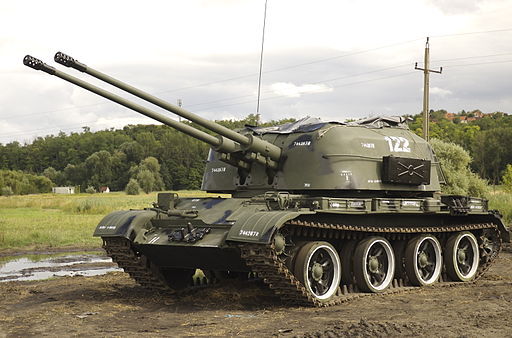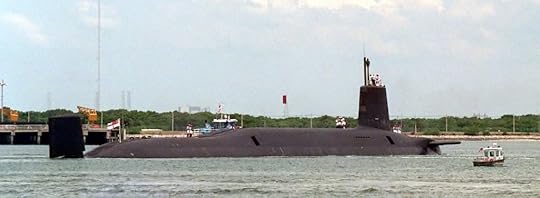Russell Phillips's Blog, page 8
April 23, 2017
Lidice Thunderclap and Giveaway
March 22, 2017
A Ray of Light short listed for the inaugural Arnold Bennett Literary Prize
March 21, 2017
Getting Kids Started in Wargaming
January 24, 2017
The CIA did not try to force Britain to hand the Falklands over to Argentina
December 26, 2016
Winter Offensive Sale
November 10, 2016
Remembrance Day 2016
September 13, 2016
Bridging the Gap: Warsaw Pact River Crossing
August 15, 2016
AFV Alphabet: Z is for ZSU-57-2
The ZSU-57-2 entered service in 1955, providing the Warsaw Pact armies with a self-propelled anti-aircraft gun that could accompany the advancing armies.

The hull is based on a lightened T-54 chassis. The armour is much lighter and it has four road wheels instead of the T-54’s five. Two air-cooled 57mm S-68 guns are fitted in a large, boxy, open-topped turret. 300 rounds of ammunition are carried, in a mix of armour-piercing, fragmentation-incendiary, and fragmentation, all of which had tracer. A tarpaulin cover is provided for protection against inclement weather.
The turret has powered traverse and elevation. Unlike the later and more successful ZSU-23-4, the ZSU-57-2 has no radar. This effectively means that it’s use is limited to clear weather conditions. It has optical sights (initially with no rangefinder, though a rangefinder was later added), which are configured to allow use in a secondary role as a ground support vehicle. Maximum effective range of the guns is around 4,000m. Armour thickness is between 8 and 15mm, and the vehicle has a top speed of 31mph, with a range of 260 miles.
Obviously, this is the last of the AFV Alphabet series. It was interesting to research and write, I hope it was also interesting to read. My thanks to Tim Gow for the inspiration.
Photo by VargaA via Wikimedia Commons (CC-BY-SA)
July 22, 2016
Don’t cut conventional arms spending to fund nukes
Jane’s has reported that the UK is having to cut spending on conventional arms, in order to pay for the new Successor class ballistic missile submarines.
 HMS Vanguard, a Trident missile submarine
HMS Vanguard, a Trident missile submarineI believe that the money spent on the nuclear deterrent would be better spent on the rest of the armed forces. One reason given for continuing Trident is that a lot of jobs depend on it. I don’t want those people to lose their jobs, but I’d much rather they were employed building and maintaining nuclear-powered attack submarines, such as the current Astute class, instead of ballistic missile submarines.
Ballistic missile submarines have one purpose. They stay hidden until called upon to deliver a nuclear strike. Nuclear-powered attack submarines, on the other hand, can perform a variety of roles, and can be of use during a conventional war. They can even help to defuse situations so that war is avoided. In 1977, Argentina pushed its claim to the Falkland Islands, and an armed invasion looked likely. The deployment of a nuclear attack submarine along with two surface ships helped to defuse the situation.
In 1982, nuclear attack submarines once again proved their worth during the Falklands War. The simple announcement that they were being deployed restricted the Argentinian navy’s freedom of movement. They provided useful reconnaissance for the British task force, and HMS Conqueror sank AMA General Belgrano. Trafalgar-class submarines have launched Tomahawk cruise missiles against targets in Afghanistan, Iraq, and Libya. Ballistic missile submarines were of no help in any of these conflicts.
Well-trained and well-equipped conventional forces are versatile in a way that ballistic missile forces never can be. They could even be used to mount attacks on nuclear research or launch facilities, should that be considered necessary. Spending on conventional forces should not be cut in order to keep a nuclear deterrent.
July 18, 2016
New Book: A Ray Of Light
 My latest book is now available – A Ray of Light: Reinhard Heydrich, Lidice, and the North Staffordshire Miners
My latest book is now available – A Ray of Light: Reinhard Heydrich, Lidice, and the North Staffordshire Miners
In March 2013, I was at the Potteries Museum in Stoke-on-Trent with my son. We were asked if we’d like to see a film about the Czech village of Lidice, destroyed by the Nazis during the Second World War.
Hitler had ordered that Lidice was to be utterly destroyed. He wanted the memory of the village to die along with its inhabitants. The miners of North Staffordshire in Great Britain, however, had other ideas. Led by a local doctor named Barnett Stross, they organised a fund-raising campaign to pay for a new village to be built once the war was won.
During the Cold War, relations with Czechoslovakia became strained, and the story was largely forgotten. The story that should be widely known, and I’m pleased to be able to do my part in spreading awareness.
It is available now in paperback and ebook (Kindle, iBooks, Kobo). It will be available from other ebook retailers shortly.



